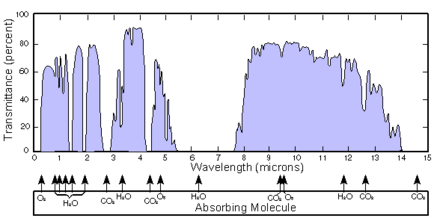
In infrared astronomy, the J band refers to an atmospheric transmission window (1.1 to 1.4 μm) centred on 1.25 micrometres (in the near-infrared).
Betelgeuse is the brightest near-IR source in the sky with a J band magnitude of −2.99.[1] The next brightest stars in the J band are Antares (−2.7), R Doradus (−2.6), Arcturus (−2.2), and Aldebaran (−2.1).[2] In the J band Sirius is the 9th brightest star.
The J band is a frequent source of ground based observations since the wavelengths it covers pass through clouds and other atmospheric gasses.[3] The waveband does however suffer from contamination by water vapor lines and hydroxide emission lines leading to relatively high photometric error.[4]
It can be used to scrutinize the photosphere of giant and supergiant stars while mostly avoiding opacities from molecular bands and also has access to the 1080 nm He I line which is useful in the study of circumstellar disk interactions around T-Tauri stars.[5] J, H and K-band spectroscopy is also commonly used to observe and research brown dwarfs[6] and directly imaged exoplanets.[7]
- ^ R. Cutri and M. Skrutskie (2009-09-07). "Very Bright Stars in the 2MASS Point Source Catalog (PSC)". The Two Micron All Sky Survey at IPAC. Retrieved 2011-12-28.
- ^ "Simbad object query:Jmag<-2 & Vmag>-9". SIMBAD Astronomical Database. Retrieved 2012-08-22.
- ^ "Infrared Astronomy Optical Filters". www.andovercorp.com. Retrieved 2023-04-01.
- ^ Simons, D. A.; Tokunaga, A. T. (February 2002). "The Mauna Kea Observatories Near-Infrared Filter Set. I: Defining Optimal 1-5 $\mu$m Bandpasses". Publications of the Astronomical Society of the Pacific. 114 (792): 169–179. arXiv:astro-ph/0110594. doi:10.1086/338544. ISSN 0004-6280. S2CID 7880289.
- ^ Pedretti, Ettore; Piacentini, S.; Corrielli, G.; Osellame, Roberto; Minardi, Stefano (2018-07-09). "A six-apertures discrete beam combiners for J-band interferometry". In Tuthill, Peter G.; Creech-Eakman, Michelle J.; Mérand, Antoine (eds.). Optical and Infrared Interferometry and Imaging VI. Vol. 10701. SPIE. pp. 316–325. arXiv:1809.01260. Bibcode:2018SPIE10701E..16P. doi:10.1117/12.2312033. ISBN 9781510619555. S2CID 119458175.
- ^ Kirkpatrick, J. Davy; Cushing, Michael C.; Gelino, Christopher R.; Griffith, Roger L.; Skrutskie, Michael F.; Marsh, Kenneth A.; Wright, Edward L.; Mainzer, A.; Eisenhardt, Peter R.; McLean, Ian S.; Thompson, Maggie A.; Bauer, James M.; Benford, Dominic J.; Bridge, Carrie R.; Lake, Sean E. (2011-12-01). "The First Hundred Brown Dwarfs Discovered by the Wide-field Infrared Survey Explorer (WISE)". The Astrophysical Journal Supplement Series. 197 (2): 19. arXiv:1108.4677. Bibcode:2011ApJS..197...19K. doi:10.1088/0067-0049/197/2/19. ISSN 0067-0049. S2CID 16850733.
- ^ Oppenheimer, B. R. (2013). "Reconnaissance of the HR 8799 Exosolar System I: Near IR Spectroscopy". The Astrophysical Journal. 768 (1). Cornell University: 24. arXiv:1303.2627. Bibcode:2013ApJ...768...24O. doi:10.1088/0004-637X/768/1/24. S2CID 7173368.